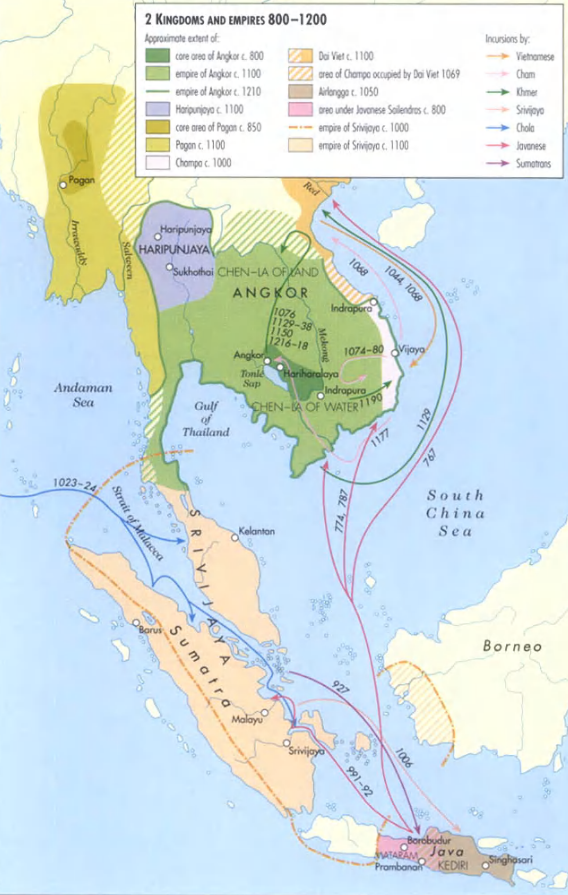Kingdoms and Empires of Southeast Asia Map


Marcus Rodriguez
Historical Geography Expert
Marcus Rodriguez specializes in historical cartography and geographic data analysis. With a background in both history and geography, he brings unique...
Geographic Analysis
What This Map Shows
This map highlights the kingdoms and empires that flourished in Southeast Asia between 800 and 1200 AD. It provides a visual representation of the political landscape of the region during this period, showcasing the various dominant powers, their territories, and the cultural interactions that shaped Southeast Asia's history. The map illustrates a time of significant trade, cultural exchange, and territorial expansion, highlighting the complexity of the region’s political entities.
Deep Dive into Kingdoms and Empires in Southeast Asia
During the period from 800 to 1200 AD, Southeast Asia was a mosaic of kingdoms and empires, each contributing to the rich tapestry of cultural and political life. This era was marked by the rise of powerful maritime states and the establishment of trade routes that connected the region with the rest of Asia and beyond.
One of the most prominent entities was the Srivijaya Empire, which emerged in the late 7th century and thrived until the 13th century. Centered in present-day Indonesia, Srivijaya controlled vital trade routes between China and India, facilitating the exchange of goods such as spices, textiles, and precious metals. Interestingly, it was not just trade that flourished—Buddhism spread throughout the region largely due to Srivijaya's influence, as it became a hub for scholars and monks.
To the north, the Khmer Empire was making its mark in present-day Cambodia and Thailand. Known for its impressive architectural achievements, including the world-renowned Angkor Wat temple complex, the Khmer Empire was a powerhouse of agriculture and irrigation. The empire's sophisticated water management systems allowed for rice cultivation and supported a growing population, which in turn contributed to its economic strength.
Meanwhile, the Pagan Kingdom in modern-day Myanmar emerged as a significant player in the region during this period. Established in the 9th century, Pagan unified various tribes and laid the groundwork for what would become a lasting legacy of Burmese culture and governance. The kingdom is particularly noted for its thousands of Buddhist temples, which reflect the spiritual and artistic achievements of the time.
The spread of Islam also began to take root during this period, particularly along the trade routes. Maritime traders from the Arabian Peninsula and India began to settle in coastal areas, leading to the establishment of early Islamic sultanates in places like Malacca. This shift would later have profound implications for the region's cultural and religious landscape.
Regional Analysis
Examining the map reveals distinct regional characteristics. For instance, while the Srivijaya Empire dominated maritime trade in the southern regions, the Khmer Empire's influence was most strongly felt in the inland areas of Southeast Asia. The Khmer's agricultural prowess allowed them to expand their territory, while Srivijaya's control over the seas facilitated cultural exchanges and trade.
The Pagan Kingdom's central location positioned it as a bridge between the Indian and Chinese influences, allowing for a unique blend of cultures and traditions. The interaction between these regions is particularly fascinating; for instance, have you noticed how the art and architecture of the Khmer Empire show Indian influence, while still maintaining local styles? This fusion is a testament to the interconnectedness of these kingdoms.
Additionally, the rise of Islamic states along the coasts indicates a significant cultural shift that would shape the region for centuries to come. The blend of indigenous traditions with new religious practices illustrates the dynamic nature of Southeast Asia's historical development, which cannot be understood in isolation from its neighbors.
Significance and Impact
Understanding the kingdoms and empires of Southeast Asia during this period is crucial for grasping the historical context of the region today. The political boundaries established then laid the groundwork for modern nations. The trade routes developed during this era not only facilitated commerce but also cultural exchanges that have influenced the region’s diverse cultural heritage.
Interestingly, the echoes of this historical interplay are still evident today. The multicultural mosaic of Southeast Asia, comprising a multitude of ethnicities and religions, can trace its roots back to this era of empires and trade. Moreover, contemporary issues in the region, such as the management of resources, the impact of globalization, and the resurgence of regional identities, can be seen as reflections of the historical dynamics illustrated in this map.
As Southeast Asia continues to evolve, reflecting on the kingdoms and empires of the past offers valuable insights into the complexities of its modern identity. The region’s ability to adapt and incorporate influences throughout its history positions it as a vibrant and resilient part of the global community, making the study of its historical kingdoms not just an academic exercise but a lens through which we can view its future.
Visualization Details
- Published
- September 11, 2025
- Views
- 98
Comments
Loading comments...